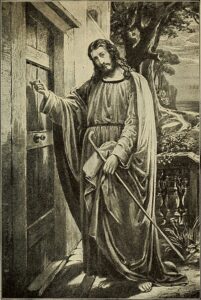“Then I saw in the right hand of him who was seated on the throne a scroll written within and on the back, sealed with seven seals. And I saw a mighty angel proclaiming with a loud voice, ‘Who is worthy to open the scroll and break its seals?’
And no one in heaven or on earth or under the earth was able to open the scroll or to look into it, and I began to weep loudly because no one was found worthy to open the scroll or to look into it” (Revelation 5:1-4 ESV).
An ancient debtor who lacked the financial resources needed to redeem a piece of property could turn to a relative to do so on his or her behalf. That relative was known as a Kinsman Redeemer. Anyone who aspired to fulfill that role had to meet three qualifications:
- He had to maintain a family relationship to the debtor.
- He had to possess the resources necessary to settle the debtor’s financial obligation.
- He had to express a willingness to act in that capacity.(1)
So what does this have to do with the scroll in the right hand of the One who sat upon this throne? Well, the double-sided inscription on this scroll suggests that it functioned as a legal document pertaining to property rights. If so, then we should consider the possibility that it served as a title deed to this world. Consider the following sequence of events in support of this idea:
- This world was “deeded” to Adam in the Garden of Eden when God directed him to subdue the Earth (Genesis 2:15-17).
- Adam forfeited that obligation (and those of his descendants) when he disobeyed God’s directive at His enemy’s behest (Genesis chapter three).
- Adam’s forfeiture enabled that enemy to assume property management responsibilities, so to speak. This explains why Satan is called “the god of this world” (2 Corinthians 4:3-4) and “the ruler of this world” (by Jesus) in John 12:31.
However, Revelation 5:2-4 alerts us to a seemingly insurmountable problem: “And I saw a strong angel, who shouted with a loud voice: ‘Who is worthy to break the seals on this scroll and open it?’ But no one in heaven or on earth or under the earth was able to open the scroll and read it. Then I began to weep bitterly because no one was found worthy to open the scroll and read it” (NLT).
So John, our author, wept with disappointment at the fact that no one seemed to possess the authority to break these seals. However, a Kinsman Redeemer was about to make His presence known.
(1) The most prominent Biblical illustration of the function of a Kinsman Redeemer appears in the Book of Ruth


 This passage then continues with an important detail regarding this scroll, for we are told that it was inscribed on both sides. Although ancient scrolls were typically single-sided, many commentators note that title deeds formed an exception. For instance, the inner portion of a title deed offered a description of the property in question. If a financial hardship led to the sale of that property, the amount owed and repayment terms were written on the outside. Once that information was transcribed, the scroll was refastened with strings and sealed with wax over the knots for security purposes.
This passage then continues with an important detail regarding this scroll, for we are told that it was inscribed on both sides. Although ancient scrolls were typically single-sided, many commentators note that title deeds formed an exception. For instance, the inner portion of a title deed offered a description of the property in question. If a financial hardship led to the sale of that property, the amount owed and repayment terms were written on the outside. Once that information was transcribed, the scroll was refastened with strings and sealed with wax over the knots for security purposes. Lightning is among the many wonders of our natural world. A lightning strike with an accompanying peal of thunder may be breathtaking or terrifying, depending on your proximity. Thus, it serves as an excellent representation of God’s immense power. That reference here in Revelation 4:5 is followed by a second appearance of “the seven Spirits” mentioned earlier in
Lightning is among the many wonders of our natural world. A lightning strike with an accompanying peal of thunder may be breathtaking or terrifying, depending on your proximity. Thus, it serves as an excellent representation of God’s immense power. That reference here in Revelation 4:5 is followed by a second appearance of “the seven Spirits” mentioned earlier in  While a royal throne is relatively easy to visualize, it is little more than a highly ornamented armchair if we strip those embellishments away. A throne will not confer special status upon anyone who sits upon it, except perhaps to document his or her experience on social media.
While a royal throne is relatively easy to visualize, it is little more than a highly ornamented armchair if we strip those embellishments away. A throne will not confer special status upon anyone who sits upon it, except perhaps to document his or her experience on social media. passage from Revelation 4:1. Those words are “meta tauta” in the original language of each verse, or “after this.” In other words, the end of Revelation 1:19 corresponds with the beginning of Revelation 4:1.
passage from Revelation 4:1. Those words are “meta tauta” in the original language of each verse, or “after this.” In other words, the end of Revelation 1:19 corresponds with the beginning of Revelation 4:1. Finally, we have this: “…write down… what is going to happen after these things” (GW). This is where the book of Revelation begins to talk about the future, or “…what will be after these things” (NET). With this in mind, we can say that this passage speaks of…
Finally, we have this: “…write down… what is going to happen after these things” (GW). This is where the book of Revelation begins to talk about the future, or “…what will be after these things” (NET). With this in mind, we can say that this passage speaks of… One of the more striking parallels between the first-century church of Laodicea and our twenty-first century world is a mutual sense of apathy or indifference. That common thread of complacency makes Jesus’ message to this church especially relevant for today.
One of the more striking parallels between the first-century church of Laodicea and our twenty-first century world is a mutual sense of apathy or indifference. That common thread of complacency makes Jesus’ message to this church especially relevant for today. For instance, we might assume that Jesus served as the primary object of worship in the church of Laodicea. But if that was true, then why was He made to wait outside, as implied in the verse quoted above? Furthermore, why did He have to request entry into what was allegedly His church? The most plausible explanation is that this was the church of the Laodiceans, and not Jesus’ church in Laodicea. This likely meant that the church of Laodicea had very little in common with Jesus, except perhaps in name only.
For instance, we might assume that Jesus served as the primary object of worship in the church of Laodicea. But if that was true, then why was He made to wait outside, as implied in the verse quoted above? Furthermore, why did He have to request entry into what was allegedly His church? The most plausible explanation is that this was the church of the Laodiceans, and not Jesus’ church in Laodicea. This likely meant that the church of Laodicea had very little in common with Jesus, except perhaps in name only. On the other hand, an excellent teacher or coach will motivate, instruct, and correct students and athletes in order to enable them to perform at their highest level. Our text from Revelation 3:19 tells us that Jesus does much the same in our spiritual lives. Although it is rarely easy to face correction and discipline, those qualities enable us to secure the growth and development that God seeks for us.
On the other hand, an excellent teacher or coach will motivate, instruct, and correct students and athletes in order to enable them to perform at their highest level. Our text from Revelation 3:19 tells us that Jesus does much the same in our spiritual lives. Although it is rarely easy to face correction and discipline, those qualities enable us to secure the growth and development that God seeks for us.